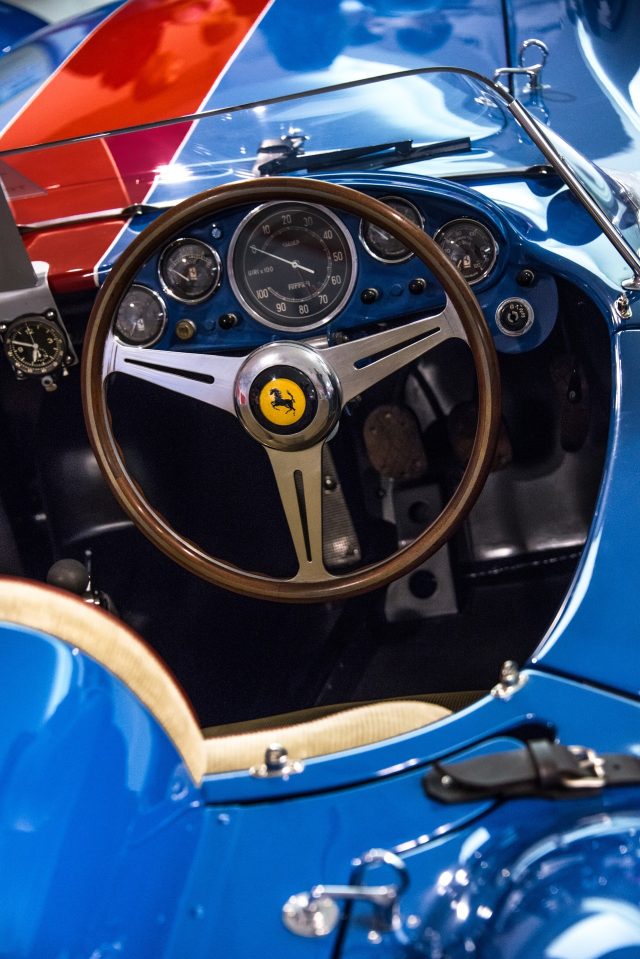
In the fascinating spaces of Palazzo Attems Petzenstein in Gorizia, a one-of-a-kind exhibition is reawakening the imagination of a roaring era: Italia Sessanta.
The exhibition, which will continue until November 17, opens with a spectacular 1965 Ferrari 275 GTB, designed by Pininfarina, the perfect symbol of a decade marked by innovation and the drive towards the future. Inserted into the context of the natural setting of the garden that surrounds the palace, the Ferrari welcomes visitors by immediately evoking the fervor and energy of those years.
The continuity of a cultural project
Italia Sessanta is part of a project that the Gorizia museum, directed by Raffaella Sgubin, has undertaken to tell the story of the evolution of Italian society through the lens of Made in Italy. The initiative, which celebrates one decade at a time, began with Italia Cinquanta in 2023, and will now continue with Italia Sessanta. The aim is to enhance and narrate, through art, fashion and design, Italian creativity and its cultural and social impact. This journey will symbolically culminate in 2025, the year in which Gorizia and Nova Gorica will be European Capitals of Culture.
Fashion and design: the aesthetics of optimism
The exhibition in Gorizia, curated by Carla Cerutti, Enrico Minio Capucci, Raffaella Sgubin and Lorenzo Michelli, represents a visual journey through vibrant colours, innovative materials and unique shapes. Italia Sessanta explores how the decade was marked by an expansion of the boundaries of art and fashion, giving life to new aesthetic expressions. We immediately enter the heart of the fashion of the Sixties, dominated by the geometries of optical art, which give an almost psychedelic dimension to elegant evening dresses. These garments represent the stylistic game that confuses the viewer’s perception with contrasts of black and white and dynamic lines, evoking an era in which stylistic experimentation was synonymous with emancipation.
Innovation and personality in the world of fashion
The great Italian designers contributed to making the decade a milestone in international fashion. Roberto Capucci, Emilio Pucci, Elio Fiorucci, Missoni, Mila Schön and Gucci are just some of the protagonists who brought innovation to every corner of the wardrobe: boldly colored dresses, glasses that became real pop accessories, fringes, transparencies and models that challenged conventions. Valentino, master of timeless elegance, exhibited some creations that embodied Italian refinement, with studied details and meticulous care that made him famous throughout the world. The fashion of those years dared to challenge traditional canons, reflecting a society that was opening up to new freedoms and that found in clothing a way to express identity and autonomy.
Design objects: the charm of functionality and beauty
Italian design from the 1960s is celebrated at Italia Sessanta with a selection of objects that have remained iconic, such as the Selene chair by Vico Magistretti, the table lamp by Gae Aulenti and the modular module by Kartell designed by Anna Castelli Ferreri. These objects embody the essence of functional, democratic and stylistically cutting-edge design. Innovations such as plastic, for example, make design accessible to all, transforming domestic environments and proposing a new vision of furniture. Thanks to the imagination and ingenuity of designers, common objects become true works of art to be exhibited, a sign of a contemporary and constantly moving lifestyle.
A journey through time: between pop culture and new artistic languages
The world of pop enters fully into the exhibition, with elements ranging from Diabolik comics to the works of Valerio Adami, up to the iconic elements of popular cinema, such as the red beanbag chairs that evoke the world of Fantozzi. It is a historical period in which the boundaries between art, cinema and design are becoming increasingly blurred, giving rise to a “popular” art that is able to speak to an increasingly wider audience. It is therefore not surprising that younger visitors are intrigued and perplexed by objects that are no longer in use, such as the jukebox, a testimony to a bygone era, but full of charm and technological innovations that have marked history.
Nature and imagination: an aesthetic in transformation
The Sixties also represent a time of great aesthetic transformation, where natural elements such as leaves, trees and animals find space in interior design and fashion. Designers push themselves towards new experiments, bringing fringes, bold lengths and eccentric patterns to the catwalk. The aim was to break the mold, to reinvent every aspect of daily life, including the way of living, dwelling, working and even loving. In a decade in which optimism dominated the scene, even plastic materials become precious tools of creative expression and are inserted into fashion and furnishings with a sensitivity that still fascinates today.
The exhibition and the accompanying volume
The experience of the exhibition is enriched by a volume, published by Antiga Edizioni with graphic design by Studio Polo 1116, which offers an opportunity to delve into the details of the period and its protagonists. Pages to browse, which tell the epic of Made in Italy of the Sixties through images and texts. Italia Sessanta is not just an exhibition, but a cultural story that conveys the creative fervor of an era, inviting visitors to immerse themselves in a journey through time. It is an opportunity to celebrate the aesthetics, fashion, design and ideas that have shaped Italian society, giving life to a legacy of style, elegance and innovation.



 Subscribe
Subscribe